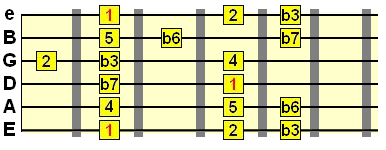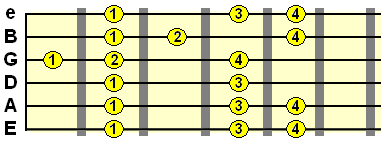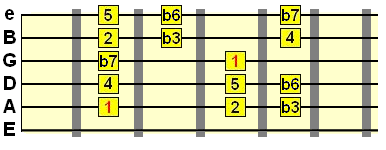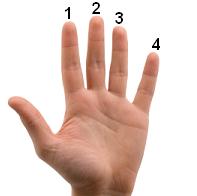Home
> Scales
>
Aeolian
When referenced in a non-modal context, the Aeolian mode is simply known as the natural minor scale. Why "natural"? For one, this helps us distinguish it from other minor scales (e.g. harmonic and melodic minor). Don't worry about those right now.
Just like the other modes, Aeolian has it's own unique flavour and is probably the most commonly used minor mode in music (especially contemporary, popular music).
Hear it (A Aeolian)
You should also know how the flat 7th (♭7) is a natural tone used in the minor modes.
We learned that the flat 6th was part of Phrygian (another minor mode), but because the rest of Aeolian is slightly different to Phrygian, that flat 6th will paint a rather different picture, when used with the other tones in the scale.
Listen to the Aeolian interval sequence below, which makes use of its key tones, to introduce you to its "flavour":
2 ♭3 1 ♭6 ♭7 4 5 1 ♭3 4 2 ♭7 1
Click to hear

See how it spans 3 root notes, so you effectively have 3 octaves to experiment with.
What about finger positions?

Watch out for that little back step in the pattern on the G string. You may have a better way of working around that. The above diagram is just a guide!
Here's a simple example of using this box pattern in A...

Click to hear
The key note to be careful with the Aeolian mode is the flat 6th. We heard it earlier as part of an interval sequence, but over a minor chord it's rather different.
See, if you hold the flat 6th over a minor chord, it won't sound too harmonious. Take a listen:
Flat 6th held over a minor chord
It may be good for a kind of atmospheric, tense effect.
So how can we use the flat 6th more... musically? There are a couple of ways to accomplish this. First, you can use the flat 6th as a passing tone. This is where you skip over it as if it's a bridge between two more stable tones in the scale. For example, you could sandwich the flat 6th within a sequence like this...
5 1 ♭7 ♭6 5 4 5
Take a listen
By merging the flat 6th into a larger phrase, it puts it into context and therefore removes the unharmonious tension created if you simply hold the flat 6th over a minor chord.
You can also use the flat 6th in a hammer-on/pull-off sequence:
Take a listen
So the main thing to remember when you're creating phrases in Aeolian is to glance over that flat 6th tone as part of a sequence, rather than emphasising the flat 6th as a resting note.
All the other tones of Aeolian are pretty neutral as far as minor harmony goes. In fact, leave out the ♭6 and you're simply left with the minor pentatonic scale with an added 9th - used all the time in rock, metal and blues.
Just like the other modes, Aeolian can work over more than one chord, with the right chord progression. We call these modal chord progressions because they support and highlight a given mode's color.
Below I've created a backing track in the key of A minor, which is compatible with A Aeolian. The main chord to focus on is known as the tonic chord. This is, in this example, A minor. The other chords you'll hear in the progression are also compatible with A Aeolian, but the notes of Aeolian will interact differently with these non-tonic chords.
So, in a nutshell, build up phrases over these chords, but focus the resolution of these phrases on that tonic A minor chord. That tonic chord will bring out the Aeolian flavour and disperse it through the progression in that context.
Just have fun with it. Don't, however, just play the Aeolian notes up or down in sequence from 1 to 7, try skipping strings, staggering the patterns of your phrases etc. but keep in mind what we've learned about that rebellious flat 6th tone!
Download A Aeolian backing track here (right click and "save as")
A Aeolian box patterns

5
17

12
More Guitar Scales Lessons
Aeolian Mode on Guitar
Note that this lesson is part of the Guitar Modes series. The Aeolian mode is the 6th mode of the major scale. Therefore, Aeolian begins on the 6th degree of the major scale. Free
scale pattern cheat sheet Free
scale pattern cheat sheetEssential scale patterns that every guitarist must know... Click here to start now |
When referenced in a non-modal context, the Aeolian mode is simply known as the natural minor scale. Why "natural"? For one, this helps us distinguish it from other minor scales (e.g. harmonic and melodic minor). Don't worry about those right now.
Just like the other modes, Aeolian has it's own unique flavour and is probably the most commonly used minor mode in music (especially contemporary, popular music).
Aeolian mode intervals
1
W
2 H ♭3 W 4
W
5 H ♭6
W
♭7 W 1
Hear it (A Aeolian)
Don't know what the W's and H's mean? If so, take the intervals lesson here before you go on.
From the previous minor mode lessons (Phrygian and Dorian), you should be familiar with the significance of the flat 3rd (♭3), also known as the minor 3rd. This makes Aeolian a minor mode, as it includes the basic minor triad (also used to create minor chords): 1 ♭3 5.You should also know how the flat 7th (♭7) is a natural tone used in the minor modes.
We learned that the flat 6th was part of Phrygian (another minor mode), but because the rest of Aeolian is slightly different to Phrygian, that flat 6th will paint a rather different picture, when used with the other tones in the scale.
Listen to the Aeolian interval sequence below, which makes use of its key tones, to introduce you to its "flavour":
2 ♭3 1 ♭6 ♭7 4 5 1 ♭3 4 2 ♭7 1
Click to hear
Aeolian mode on guitar
As with the other mode lessons, let's first look at Aeolian mode in its first position boxed pattern:

See how it spans 3 root notes, so you effectively have 3 octaves to experiment with.
What about finger positions?

Watch out for that little back step in the pattern on the G string. You may have a better way of working around that. The above diagram is just a guide!
Here's a simple example of using this box pattern in A...

Click to hear
Playing Aeolian over chords
As mentioned earlier, Aeolian is a minor mode/scale (due to the minor 3rd interval) so it will work over... minor chords! As a mode, it will also work over a sequence of chords, but this will become clearer when we play over the jam track later.The key note to be careful with the Aeolian mode is the flat 6th. We heard it earlier as part of an interval sequence, but over a minor chord it's rather different.
See, if you hold the flat 6th over a minor chord, it won't sound too harmonious. Take a listen:
Flat 6th held over a minor chord
It may be good for a kind of atmospheric, tense effect.
So how can we use the flat 6th more... musically? There are a couple of ways to accomplish this. First, you can use the flat 6th as a passing tone. This is where you skip over it as if it's a bridge between two more stable tones in the scale. For example, you could sandwich the flat 6th within a sequence like this...
5 1 ♭7 ♭6 5 4 5
Take a listen
By merging the flat 6th into a larger phrase, it puts it into context and therefore removes the unharmonious tension created if you simply hold the flat 6th over a minor chord.
You can also use the flat 6th in a hammer-on/pull-off sequence:
Take a listen
So the main thing to remember when you're creating phrases in Aeolian is to glance over that flat 6th tone as part of a sequence, rather than emphasising the flat 6th as a resting note.
All the other tones of Aeolian are pretty neutral as far as minor harmony goes. In fact, leave out the ♭6 and you're simply left with the minor pentatonic scale with an added 9th - used all the time in rock, metal and blues.
Aeolian mode jam track
Ok! So here we are with another jam track to help us experiment with our own ideas.Just like the other modes, Aeolian can work over more than one chord, with the right chord progression. We call these modal chord progressions because they support and highlight a given mode's color.
Below I've created a backing track in the key of A minor, which is compatible with A Aeolian. The main chord to focus on is known as the tonic chord. This is, in this example, A minor. The other chords you'll hear in the progression are also compatible with A Aeolian, but the notes of Aeolian will interact differently with these non-tonic chords.
So, in a nutshell, build up phrases over these chords, but focus the resolution of these phrases on that tonic A minor chord. That tonic chord will bring out the Aeolian flavour and disperse it through the progression in that context.
Just have fun with it. Don't, however, just play the Aeolian notes up or down in sequence from 1 to 7, try skipping strings, staggering the patterns of your phrases etc. but keep in mind what we've learned about that rebellious flat 6th tone!
Download A Aeolian backing track here (right click and "save as")
A Aeolian box patterns

5
17

12
| |
Tweet |
Related
Main Guitar Modes SectionMore Guitar Scales Lessons








